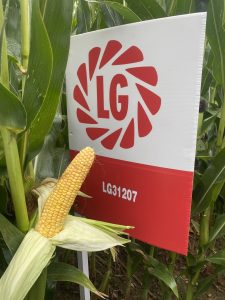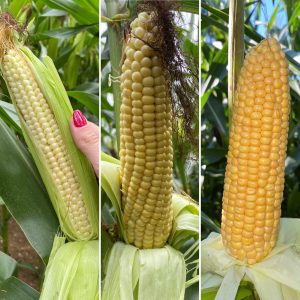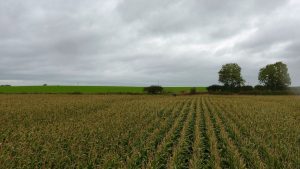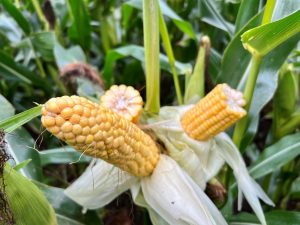Trials are underway in Cornwall and have previously been run to show the effects of strip till drilling compared to conventional ploughing cultivation and its positive effects.
The main benefits of no-till being; a reduction of costs in time and diesel, to help improve soil health and organic matter and to reduce chances of capping and soil erosion. Although no significant yield differences have been found, are there any other differences that need to be considered when trying an alternative cultivation techniques?
Picking a maize variety with a maturity FAO that fits within your rotation and planned harvest date is an important decision, especially with the prolonged bouts of weather extremes we are currently experiencing, but does altering your drilling method have any bearing on this? Some farm-based in the Southwest have shown an increase in maturity length by a couple of weeks from the same variety grown in the same field. As maize is a lazy rooting crop, it is thought that the extra time is needed for the roots to set in a less worked seed bed. This can have a major potential knock-on effect for the rotation or the ability to get the crop harvested at an appropriate weather window in line with the crop maturity.
Switching to an earlier maize variety when looking at reducing cultivation could be key for still achieving that earlier harvest for your maize. Growing earlier varieties such as Prospect, Trooper and Duke with high vigour scores fit this scenario well!

As we emerge from what has seemed like one of the wettest winters in recent times finally some field work is starting to take place. Muck is being spread, grass being cut, fields starting to be prepared and now thoughts turn to maize drilling.
Before we think about drilling, we need to get the absolute essentials right which is to first consider the variety to grow. The difference in maize varieties is vast and many factors influence what variety you may choose to grow. Certainly, for my own customers there has been a re-focus on growing earlier varieties such as Prospect, Trooper and Duke because of the challenging harvest period we faced in 2023. Varieties also vary in other factors that growers may not be aware of, such as vigour, disease, digestibility and starch content. There have also been variations in disease pressure this past year, particularly fusarium. Fusaruim kills the plant prematurely and its prevalence is down to a number of factors including climatic and varietal, Prospect, Ambition and promise have coped very well this year.
Getting seed bed and soil conditions correct is another basic that must be right for a successful crop. There is an acceptance that maize has “lazy roots” so it is important to avoid any compaction and attain deep loose seed beds. Weed pressure needs to be managed where required with caution needed when applying herbicides at high temperatures.
When should I drill? Well, the rule of starting to drill when soil temperatures reach 8°C for five consecutive days or 6°C for maize grown under degradable film should be applied. It is important to note that soil temperatures fluctuate more in lighter soils so forecasts need to be looked at and trying to plant after any forecasted frosts. Maize is a crop that should always be sown into moisture. Drilling depth can vary from 2.5 to 10 centimetres, it all depends on where the soil moisture depth is, although growers this year will not likely need to look deep! Seed rates vary from around 35,000 seeds an acre for grain maize to forage maize at 40,000 seeds an acre on light sandy favourable ground and 45,000 seeds an acre for earlier planting on heavier ground.
Our seed specialists are always on hand for advice regarding choosing the correct variety for your farm and all aspects of seed rates and drilling depths at anytime.
Call Fraser on:
07811 746 589
As we are at the beginning of the new year, I find myself thinking about how last year went and what we have learned from it.
After a very difficult start to the maize drilling season in spring, with a lot of the 2023 maize crops going in late, a wet mid-summer and a very difficult harvesting season, choosing the right maize variety seems more important than ever.
There are a lot of factors that contribute to having a high yield of maize, and choosing the right variety for the right type of ground is one of the most essential ones.
It’s easy enough to pick a variety that has early maturity but how that variety gets to mature is crucial for a good harvest, that is why we are looking at choosing varieties with high early vigour, good standing power and leaf senescence.
This is especially useful when we have a delayed drilling season, as varieties with high early vigour will emerge better, getting to pollination earlier, with a higher chance of producing a good, full cob and reaching harvesting maturity faster than varieties from the same maturity group.
One of those varieties is Prospect, with an FAO of 170 and an early vigour of 7.2, standing power of 7.7 and leaf senescence at 7.3, it can be drilled from the main drilling season up until end of May and will still reach harvest maturity before the end of September in the Midlands area.
Besides being used for forage and AD, Prospect can also be used as a grain variety with an early grain finish and high yield.
Another interesting variety that has performed very well this last year in our area is the LG31.207, a late maturing variety with a 210 FAO, but despite being from a late maturity group it makes up for it in early vigour of 8.2 with a standing power of 8 and a harvest date at the end of September making it a very strong choice for the forage and especially the AD sector.
For the next maize growing season, I would suggest picking varieties that will give you an advantage over the extreme weather changes, that have a wider drilling period without affecting the harvesting date, with good early vigour, good standing, and disease tolerance as all these characteristics will contribute immensely to an early harvest with excellent yields.


Just like all of our customers, I get a really satisfying feeling looking across fields that are thriving. From a selfish point of view it’s also very gratifying to think that I have had a small part to play in a crop’s success. Mother nature plays a huge part of course, along with soil type, cultivation technique, drilling date and the subsequent agronomy decisions which need to be made along the way. Choosing the right variety, for the area, rotational slot; harvest date and forage use are where your local Nickerson Seed Specialist can help increase profitability on farm.
The diversity of the LG portfolio is as wide as it is tall, so understanding how best to express the genetic potential of the crop is an essential part of the decision making process.

This crop of Trooper grown in the North East of England, is about two weeks away from harvest and the yield potential looks stunning. The grower needs an early harvest of high dry matter and high starch silage for a beef fattening unit and he needs it consistently year on year. This will be the third year that Trooper has fulfilled the brief and its potential. It’s great on farm – reliable, with decent yields and it is a highly digestible feed crop.
.




